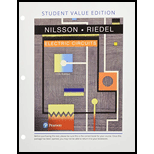
Electric Circuits, Student Value Edition Format: Unbound (saleable)
11th Edition
ISBN: 9780134747170
Author: NILSSON, James W.^riedel, Susan
Publisher: Prentice Hall
expand_more
expand_more
format_list_bulleted
Question
Chapter 14, Problem 28P
(a)
To determine
Find the value of the resistor and inductor for the given series RLC bandpass filter circuit.
(b)
To determine
Find the value of lower cutoff frequency in kilohertz for the given series RLC bandpass filter using PSpice.
(c)
To determine
Find the value of the upper cutoff frequency in kilohertz for the given series RLC bandpass filter.
(d)
To determine
Find the value of the bandwidth in kilohertz for the given series RLC bandpass filter.
Expert Solution & Answer
Want to see the full answer?
Check out a sample textbook solution
Students have asked these similar questions
1. For the following logic gates:
a. Write a Truth Table and logic equation?
A
Y
A
A.
Y
A
Y
"0"
A
A
neotoof
"0">
Day
Y
"1"
A
ADY
DY
A
B
DD
A
B
b. What each of these gates represent?
2. Connect and draw the following digital logic equations:
a. Y=X+1
b. Y=X+X' = \
c. Y=X X'
d. Y=X 0
e. Y=XX'
f. Y=XOX
3. Prove that:
a. X(Y+Z)=XY+XZ
b. X+YZ=(X+Y)(X+Z)
c. (X+Y)'=X'Y'
d. (XY)'=X'+Y
e. X+XY=X
f. X(X+Y)=X
I need help with this problem and an step by step explanation of the solution from the image described below. (Introduction to Signals and Systems: Spectrum Representation)
I need help with this problem and an step by step explanation of the solution from the image described below. (Introduction to Signals and Systems: A complex Numbers)
Chapter 14 Solutions
Electric Circuits, Student Value Edition Format: Unbound (saleable)
Ch. 14.2 - Prob. 1APCh. 14.2 - A series RL low-pass filter with a cutoff...Ch. 14.3 - Prob. 3APCh. 14.3 - Prob. 4APCh. 14.3 - Prob. 5APCh. 14.4 - Prob. 6APCh. 14.4 - Using the circuit in Fig. 14.22, compute the...Ch. 14.4 - Prob. 8APCh. 14.4 - Prob. 9APCh. 14.5 - Design the component values for the series RLC...
Ch. 14.5 - Prob. 11APCh. 14 - Prob. 1PCh. 14 - Consider the low-pass filter in Fig. P14.2, which...Ch. 14 - Use a 5 mH inductor to design a low-pass, RL....Ch. 14 - A resistor, denoted as Rl, is added in series with...Ch. 14 -
Use a 250 Ω resistor to design a low-pass passive...Ch. 14 - Consider the low-pass filler designed in Problem...Ch. 14 - Find the cutoff frequency (in hertz) of the...Ch. 14 - Prob. 8PCh. 14 - Use a 500 nF capacitor to design a low-pass...Ch. 14 - Prob. 10PCh. 14 - Consider the circuit shown in Fig. P14.11.
What is...Ch. 14 - Prob. 12PCh. 14 - Prob. 13PCh. 14 - Prob. 14PCh. 14 - Prob. 15PCh. 14 - Prob. 16PCh. 14 - Prob. 17PCh. 14 - Prob. 18PCh. 14 - Prob. 19PCh. 14 - Prob. 20PCh. 14 - Prob. 21PCh. 14 - Prob. 22PCh. 14 - Prob. 23PCh. 14 - Prob. 24PCh. 14 - Prob. 25PCh. 14 - Using a 50 nF capacitor in the bandpass circuit...Ch. 14 - Design a series RLC bandpass filter using only...Ch. 14 - Prob. 28PCh. 14 - Design a series RLC bandpass filter using only...Ch. 14 - Prob. 30PCh. 14 - Consider the circuit shown in Fig. P14.31.
Find...Ch. 14 - Prob. 32PCh. 14 - The purpose of this problem is to investigate how...Ch. 14 - The parameters in the circuit in Fig. P14.33 are R...Ch. 14 - Prob. 35PCh. 14 - Prob. 36PCh. 14 - Prob. 37PCh. 14 - Prob. 38PCh. 14 - Prob. 39PCh. 14 - Prob. 40PCh. 14 - Prob. 41PCh. 14 - Use a 500 nF capacitor to design a bandreject...Ch. 14 - Prob. 43PCh. 14 - Prob. 44PCh. 14 - Prob. 45PCh. 14 - The parameters in the circuit in Fig. P14.45 are R...Ch. 14 - Prob. 47PCh. 14 - Consider the series RLC circuit shown in Fig....Ch. 14 - Repeat Problem 14.49 for the circuit shown in Fig....Ch. 14 - Prob. 51PCh. 14 - Design a DTMF high-band bandpass filter similar to...Ch. 14 - Prob. 53P
Knowledge Booster
Similar questions
- 5) Find the value of voltage V, and V₂ using Loop analysis. 5A + 4 34 ww 8 2 www 3A m 4 38 + 23V₂ 1/2 + ±) 12Varrow_forward4) Find the valve of voltage Vx using Loop analysis. 2A ( 1 3 w + 234 OV + 123arrow_forward3 Write but do not solve the set of Loop equations for this circuit www 4 १ह 15 ww 5 124 + ☹ 33 M 7A www 6 103 23 راح +arrow_forward
arrow_back_ios
SEE MORE QUESTIONS
arrow_forward_ios
Recommended textbooks for you
 Introductory Circuit Analysis (13th Edition)Electrical EngineeringISBN:9780133923605Author:Robert L. BoylestadPublisher:PEARSON
Introductory Circuit Analysis (13th Edition)Electrical EngineeringISBN:9780133923605Author:Robert L. BoylestadPublisher:PEARSON Delmar's Standard Textbook Of ElectricityElectrical EngineeringISBN:9781337900348Author:Stephen L. HermanPublisher:Cengage Learning
Delmar's Standard Textbook Of ElectricityElectrical EngineeringISBN:9781337900348Author:Stephen L. HermanPublisher:Cengage Learning Programmable Logic ControllersElectrical EngineeringISBN:9780073373843Author:Frank D. PetruzellaPublisher:McGraw-Hill Education
Programmable Logic ControllersElectrical EngineeringISBN:9780073373843Author:Frank D. PetruzellaPublisher:McGraw-Hill Education Fundamentals of Electric CircuitsElectrical EngineeringISBN:9780078028229Author:Charles K Alexander, Matthew SadikuPublisher:McGraw-Hill Education
Fundamentals of Electric CircuitsElectrical EngineeringISBN:9780078028229Author:Charles K Alexander, Matthew SadikuPublisher:McGraw-Hill Education Electric Circuits. (11th Edition)Electrical EngineeringISBN:9780134746968Author:James W. Nilsson, Susan RiedelPublisher:PEARSON
Electric Circuits. (11th Edition)Electrical EngineeringISBN:9780134746968Author:James W. Nilsson, Susan RiedelPublisher:PEARSON Engineering ElectromagneticsElectrical EngineeringISBN:9780078028151Author:Hayt, William H. (william Hart), Jr, BUCK, John A.Publisher:Mcgraw-hill Education,
Engineering ElectromagneticsElectrical EngineeringISBN:9780078028151Author:Hayt, William H. (william Hart), Jr, BUCK, John A.Publisher:Mcgraw-hill Education,

Introductory Circuit Analysis (13th Edition)
Electrical Engineering
ISBN:9780133923605
Author:Robert L. Boylestad
Publisher:PEARSON

Delmar's Standard Textbook Of Electricity
Electrical Engineering
ISBN:9781337900348
Author:Stephen L. Herman
Publisher:Cengage Learning

Programmable Logic Controllers
Electrical Engineering
ISBN:9780073373843
Author:Frank D. Petruzella
Publisher:McGraw-Hill Education

Fundamentals of Electric Circuits
Electrical Engineering
ISBN:9780078028229
Author:Charles K Alexander, Matthew Sadiku
Publisher:McGraw-Hill Education

Electric Circuits. (11th Edition)
Electrical Engineering
ISBN:9780134746968
Author:James W. Nilsson, Susan Riedel
Publisher:PEARSON

Engineering Electromagnetics
Electrical Engineering
ISBN:9780078028151
Author:Hayt, William H. (william Hart), Jr, BUCK, John A.
Publisher:Mcgraw-hill Education,